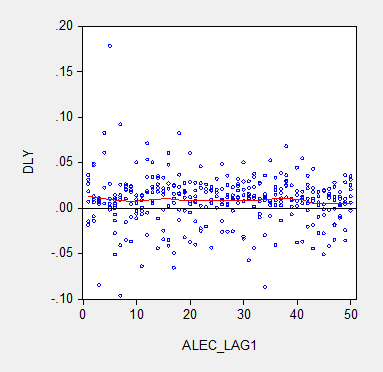Rich States, Poor States* is a popular economic analysis in Utah. In large part, this is because Utah ranks very high in their analysis (# 1 in economic outlook for most of the last 10 years).
It’s difficult to deny that Utah is on a pretty good run. Macroeconomically, the state has been thriving since the resource extraction downturn of the late 1980’s.
The position of Rich States, Poor States is that this is due to economic policies pursued by Utah’s politicians. They rank Utah # 1 in 3 of 15 policy choices: having a flat income tax, having little or no estate tax, and having a low minimum wage. These are politically conservative policies (no surprise there in Utah), and clearly the publication is cheerleading for more of those.
The thing is, a measure of economic outlook ought to have predictive power for GSP (the state level version of GDP). EconBrowser reports a bunch of regressions and charts that show … pretty much no relationship at all. Here’s an example:

This shows last year’s ALEC ranking (lower is better), versus the differenced logs (approximate growth rates) of this year’s GSP. If ALEC is on to something with their rankings of policies, the red curve should be downward sloping. It isn’t.
None of this says that Utah’s policy choices are bad. But it does say that they are no better or worse than other states.
* The full cite is Laffer, A.B., Moore, S., and Williams J., Rich States, Poor States, 2016, 9th ed., American Legislative Exchange Council: Arlington, VA.
No comments:
Post a Comment